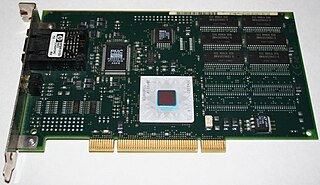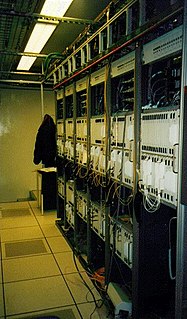
Asynchronous Transfer Mode (ATM) is a telecommunications standard defined by ANSI and ITU for digital transmission of multiple types of traffic, including telephony (voice), data, and video signals in one network without the use of separate overlay networks. ATM was developed to meet the needs of the Broadband Integrated Services Digital Network, as defined in the late 1980s, and designed to integrate telecommunication networks. It can handle both traditional high-throughput data traffic and real-time, low-latency content such as voice and video. ATM provides functionality that uses features of circuit switching and packet switching networks. It uses asynchronous time-division multiplexing, and encodes data into small, fixed-sized network packets.
Multiprotocol Label Switching (MPLS) is a routing technique in telecommunications networks that directs data from one node to the next based on short path labels rather than long network addresses, thus avoiding complex lookups in a routing table and speeding traffic flows. The labels identify virtual links (paths) between distant nodes rather than endpoints. MPLS can encapsulate packets of various network protocols, hence the "multiprotocol" reference on its name. MPLS supports a range of access technologies, including T1/E1, ATM, Frame Relay, and DSL.
In computer networking, the maximum transmission unit (MTU) is the size of the largest protocol data unit (PDU) that can be communicated in a single network layer transaction. The MTU relates to, but is not identical to the maximum frame size that can be transported on the data link layer, e.g. Ethernet frame.

A wide area network (WAN) is a telecommunications network that extends over a large geographic area for the primary purpose of computer networking. Wide area networks are often established with leased telecommunication circuits.

Frame Relay is a standardized wide area network (WAN) technology that specifies the physical and data link layers of digital telecommunications channels using a packet switching methodology. Originally designed for transport across Integrated Services Digital Network (ISDN) infrastructure, it may be used today in the context of many other network interfaces.

Synchronous optical networking (SONET) and synchronous digital hierarchy (SDH) are standardized protocols that transfer multiple digital bit streams synchronously over optical fiber using lasers or highly coherent light from light-emitting diodes (LEDs). At low transmission rates data can also be transferred via an electrical interface. The method was developed to replace the plesiochronous digital hierarchy (PDH) system for transporting large amounts of telephone calls and data traffic over the same fiber without the problems of synchronization.

Time-division multiplexing (TDM) is a method of transmitting and receiving independent signals over a common signal path by means of synchronized switches at each end of the transmission line so that each signal appears on the line only a fraction of time in an alternating pattern. This method transmits two or more digital signals or analog signals over a common channel. It can be used when the bit rate of the transmission medium exceeds that of the signal to be transmitted. This form of signal multiplexing was developed in telecommunications for telegraphy systems in the late 19th century, but found its most common application in digital telephony in the second half of the 20th century.
A virtual circuit (VC) is a means of transporting data over a packet-switched network in such a way that it appears as though there is a dedicated physical link between the source and destination end systems of this data. The term virtual circuit is synonymous with virtual connection.

A digital subscriber line access multiplexer is a network device, often located in telephone exchanges, that connects multiple customer digital subscriber line (DSL) interfaces to a high-speed digital communications channel using multiplexing techniques.
The Point-to-Point Protocol over Ethernet (PPPoE) is a network protocol for encapsulating Point-to-Point Protocol (PPP) frames inside Ethernet frames. It appeared in 1999, in the context of the boom of DSL as the solution for tunneling packets over the DSL connection to the ISP's IP network, and from there to the rest of the Internet. A 2005 networking book noted that "Most DSL providers use PPPoE, which provides authentication, encryption, and compression." Typical use of PPPoE involves leveraging the PPP facilities for authenticating the user with a username and password, predominately via the PAP protocol and less often via CHAP.
A leased line is a private telecommunications circuit between two or more locations provided according to a commercial contract. It is sometimes also known as a private circuit, and as a data line in the UK. Typically, leased lines are used by businesses to connect geographically distant offices.
The use of Asynchronous Transfer Mode (ATM) technology and services creates the need for an adaptation layer in order to support information transfer protocols, which are not based on ATM. This adaptation layer defines how to segment higher-layer packets into cells and the reassembly of these packets. Additionally, it defines how to handle various transmission aspects in the ATM layer.
In computer networking and telecommunications, a pseudowire is an emulation of a point-to-point connection over a packet-switching network (PSN).
Throughput of a network can be measured using various tools available on different platforms. This page explains the theory behind what these tools set out to measure and the issues regarding these measurements.
Switched Multi-megabit Data Service (SMDS) was a connectionless service used to connect LANs, MANs and WANs to exchange data, in early 1990s. In Europe, the service was known as Connectionless Broadband Data Service (CBDS).
The ideal telecommunication network has the following characteristics: broadband, multi-media, multi-point, multi-rate and economical implementation for a diversity of services (multi-services). The Broadband Integrated Services Digital Network (B-ISDN) was planned to provide these characteristics. Asynchronous Transfer Mode (ATM) was promoted as a target technology for meeting these requirements.
If a network service wishes to use a broadband network to transport a particular kind of traffic, it must first inform the network about what kind of traffic is to be transported, and the performance requirements of that traffic. The application presents this information to the network in the form of a traffic contract.

Statistical multiplexing is a type of communication link sharing, very similar to dynamic bandwidth allocation (DBA). In statistical multiplexing, a communication channel is divided into an arbitrary number of variable bitrate digital channels or data streams. The link sharing is adapted to the instantaneous traffic demands of the data streams that are transferred over each channel. This is an alternative to creating a fixed sharing of a link, such as in general time division multiplexing (TDM) and frequency division multiplexing (FDM). When performed correctly, statistical multiplexing can provide a link utilization improvement, called the statistical multiplexing gain.
Connection-oriented communication is a network communication mode in telecommunications and computer networking, where a communication session or a semi-permanent connection is established before any useful data can be transferred, enabling the ability to ensure that data is delivered in the correct order to the upper communication layer. The alternative to connection-oriented transmission is connectionless communication, for example the datagram mode communication used by the IP and UDP protocols, where data may be delivered out of order, since different network packets are routed independently, and may be delivered over different paths.
ATM Adaptation Layer 2 (AAL2) is an ATM adaptation layer for Asynchronous Transfer Mode (ATM), used primarily in telecommunications; for example, it is used for the Iu interfaces in the Universal Mobile Telecommunications System, and is also used for transporting digital voice. The standard specifications related to AAL2 are ITU standards I.363.2 and I366.1.





